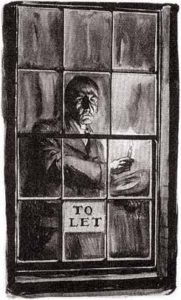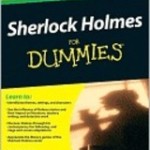A Scion Society of The Baker Street Irregulars

Data! Data! Data! – The Red Circle
“‘Data! Data! Data!‘ he cried impatiently. ‘I can’t make bricks without clay.’”
– The Adventures of The Copper Beeches (COPP)

This column is composed of material (Data!) developed for a short course called Appreciating Sherlock Holmes that I teach twice a year in the Community Education Life Enrichment Program for a local community college. It is composed of “points of information” that are common to many / most / all of the 60 Canonical stories.
The information here has been researched by me or borrowed / stolen from many efforts of other Sherlockians.
HERE GOES This month’s story The Adventure of the Red Circle
F.Y.I. – The original title on the manuscript was to be The Adventure of the Bloomsbury Lodger
CHRISTOPHER MORLEY SAID . . .
“Unmitigated bleat” was Holmes’s cruel description of the sentimental messages in the newspaper Personals, known in the London press as the Agony Column. But in his daily scrapbook of these advertisements he found a clue to the mystery of Mr. Warren’s lodger, who had not been seen for ten days and communicated with the landlady only on scraps of paper.
 DUMMIES SHORT SUMMARY (From Sherlock Holmes for Dummies by Steven Doyle & David Crowder)
DUMMIES SHORT SUMMARY (From Sherlock Holmes for Dummies by Steven Doyle & David Crowder)
“A murderous secret society and a young, persecuted couple are at the heart of this story. When a young woman spurns the advance of a Mafia chief, her husband takes extraordinary action to protect her.”
PUBLISHING HISTORY
This is the 44th of the 60 stories published.
In England, it was published in The Strand Magazine, in March & April, 1911.
In the United States, it was published in The Strand Magazine, in April & May, 1911.
It was part of the His Last Bow collection, published by John Murray, London, 1917 and in the United States by George H. Doran, New York, 1927.
The British illustrators were H. M. Brock & Joseph Simpson.
HOW MANY WORDS?
According to C. E. Lauderback, 1960 – – found on SHERLOCKIAN.NET website of Chris Redmond, at 7,350 words REDC has the 19th most words (#1 is VEIL – 4,499, #56 if NAVL – 12,701).
THE BEST OF SHERLOCK HOLMES (How do Sherlockians rate this story?)
1944 – Baker Street Irregulars voted it #10 on their worst list.
1999 – Baker Street Irregulars voted it 34th of the 56 short stories.
1999 – The Sherlock Holmes Society of London voted it 30th of the 56 short stories.
CLASSIFYING THE CASE (From the Wandering Gipsies of Grimpen Mire of Decatur, Alabama)
This case is one of 3 stories classified as fear of retribution. The others are CROO and ILLU.
CHRONOLOGICALLY SPEAKING
Doyle was often very vague about stating WHEN the tale took place and included few contemporary references to help. Whether this was done intentionally or unthinkingly, the dating of events in the Canon is a very popular pastime pursued by several of our “scholars” researching and justifying their results to no end. We will again default to William Baring-Gould’s dating of Wednesday, September 24 to Thursday, September 25, 1902 making it 54th of the 60 in chronological order. This means that Holmes would be 48 and Watson 50.,
WHAT ELSE HAPPENED IN THE YEAR 1902?
It is always interesting to see what else in happening at the same time as the stories.
- First celebration of Empire Day; renamed “Commonwealth Day” in 1959.
- Anglo-German fleet seizes Venezuelan fleet to recover debts and reparations.
- Peace of Vereeniging, ends Boer War.
- Salisbury resigns, succeeded as Prime Minister by Arthur Balfour.
- Anglo-Japanese Treaty, for mutual defense and to maintain status quo in Far East.
- Education Act abolishes School Board system. Local control goes to town and county councils.
- Arthur Conan Doyle is knighted.
- Franco-Italian secret treaty; Italy to remain neutral if France were attacked by a third power.
- Triple Alliance (Germany, Austria, Italy) renewed to 1914.
- Russo-Japanese Convention, Russia agrees to evacuate Manchuria in 18 months.
- Pierre, Martinique, destroyed by earthquake.
- Abdul Hamid gives Germany concessions to build railway to Baghdad; rail system to stretch from Hamburg to the Persian Gulf.
- A. Krupp takes over Germania shipbuilding yard at Kiel; great armaments firm develops.
- A. Conan Doyle publishes The Hound of the Baskervilles.
- Kipling publishes Just So Stories.
- Beatrix Potter publishes Peter Rabbit.
- Enrico Caruso makes his first gramophone record–154 recordings in all.
- Picasso paints Nude, Back View.
- Trans-Pacific Cable laid.
- Completion of Aswan Dam in Egypt.
HOLMES AND WATSON – PERSONAL INFO
Our story has Holmes and Watson sharing quarters at 221B.
DRAMATIS PERSONAE
Not a big or distinguished cast.
- EMILIA LUCCA nee BARELLI, wife of GENNARO
- GENNARO LUCCA, an Italian refugee.
- GORGIANO, an early version of a Mafia Don.
- GREGSON
- LEVERTON of Pinkerton’s American agency.
- WARREN, the Luccas’ London Landlady who brought Holmes into the case.
- FAIRDALE HOBBS, lodger of Mrs. Warren for whom Holmes had solved a problem in the past.
“QUOTABLE SHERLOCK”
Not too many memorable lines but there are four from Holmes to Watson
- “Take time to consider. The smallest point may be the most essential.”
- “Dear me! What a chorus of groans, cries, and bleatings! What a rag-bag of singular happenings! … Bleat, Watson, unmitigated bleat!”
- “It is art for art’s sake.”
- “Education never ends, Watson. It is a series of lessons with the greatest for the last.”
HOLMES’ FEE
“It is art for art’s sake, Watson. I suppose when you doctored you found yourself studying cases without thought of a fee?” “For my education, Holmes.” (Meaning, of course, that nothing went in the bank on this one.)
SHERLOCK ON THE BIG SCREEN & THE LITTLE SCREEN
This story has been done only twice and by the most prolific film portrayers. You would think that “the Mafia types” would have been an attraction.
1922 The Red Circle was the 23rd of the 47 movies by Eille Norwood. The National Film and Television Archive at the BFI has viewing copies of this film but it has not been released.
1994 The Red Circle with Jeremy Brett and Edward Hardwick was the 39th of the 41 episodes done by BBC/Granada. Brett’s failing heath was showing.
SHERLOCK HOLMES IN DISGUISE
The Master of disguise used the deception of being disguised 14 times in 11 of the 60 stories. None were needed in this story.
UNRECORDED CASES (That involved Holmes)
Watson would tease / torture his readers with “I know something you don’t.” Oh my, how Sherlockians love this category. I have in excess of over 150 examples in my collection. None were mentioned here. Oh, to be able to have Watson’s dispatch box.
IS THERE A DOCTOR IN THE HOUSE?
Victorian London, in the Holmes’ time, had approximately 1 doctor for every 100 people. 31 of the 60 tales have a doctor in them. This, of course, does not count Holmes’ Boswell. This listing is by Leslie Klinger in the Winter, 2015 edition of the Baker Street Journal. Whether it was Doyle or Watson, a doctor wrote the story. In this story, there was no doctor involved or mentioned.
FAINTING IN THE CANON (courtesy of Sherlockian Karen Murdock)
Fainting is extremely common in the Canon, appearing, in some form, in 37 of the 60 tales. In 21 cases, someone actually faints. In 22 cases, someone almost faints. And in 5 cases, someone pretends to faint. In this tale, a lady fainted on the Brixton Bus.
HOLMES’S PUBLISHED & PROJECTED WORKS
Sherlockians love this topic and are regularly searching for these items. Holmes mentions published or projected works in 11 of the stories but none used here.
NEWSPAPERS (Real and Fictional)
Though included in only 20 tales, some of our more obsessed Sherlockians love this one. This story has the fictional Daily Gazette.
WEAPONS (from A Compendium of Canonical Weaponry by Dettman and Bedford)
So many things can be considered “weapons” that only 3 tales (CREE, 3STU, & YELL) fail to have at least one. Since this column is running long, here is a list of “weapons” with no explanation. See if you can find them in the story.
- Knife – Gennaro Lucca used to kill “Black” Gorgiano of the dreaded Red Circle.
- Horn-Handled, Double-Edged Dagger – Of Gorgiano, found, unused beside its owner’s body.
- Fist – Of Gorgiano, with which he knocked Gennaro Lucca Senseless.
- Blackmail Dealings – OF the Red Circle, an Italian secret society active in the United States.
- Coat – Which two ruffians under the hire of Giorgiano of the Red Circle used to subdue Mr. Warren, mistaking him for Gennaro Lucca.
- Dynamite – Which the Red Circle ordered Lucca to use to blow up the house of Mr. Castalotte.
 Frank Mentzel, aka Merridew of Abominable Memory, is preparing for his fall class of Appreciating Sherlock Holmes in October and has been working in his garden when it wasn’t raining this summer..
Frank Mentzel, aka Merridew of Abominable Memory, is preparing for his fall class of Appreciating Sherlock Holmes in October and has been working in his garden when it wasn’t raining this summer..

Sorry, comments are closed for this post.